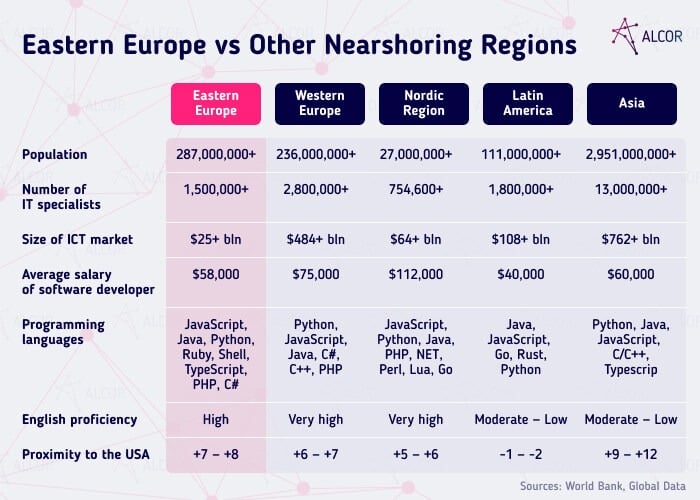Take the top 5 countries for software nearshoring and offshoring globally, all located in Eastern Europe, add more than 1,5M talented IT professionals, and you get the recipe for the perfect destination for your tech business expansion. But what exactly does nearshore software development to Eastern Europe bring to the table for your tech business, and how does this market differ from those in Western Europe, Asia, or Latin America?
I’m Dmytro Ovcharenko, the CEO and founder of Alcor, a full-cycle R&D service provider for Western tech product companies. As a perfect alternative to outsourcing, Alcor offers end-to-end tech recruitment and EoR services across 9 countries in LATAM and EE with no legal entity needed to establish.

In this article, I will outline an overview of the Eastern European IT market for businesses and the 5 countries of the region with the best-developed tech industry. Additionally, I will compare EE with other regions, outline the main advantages and challenges of nearshoring software development to Eastern Europe, and offer an effective solution to run your business in this region.
Eastern Europe IT Market Overview
According to the Future of IT Report 2023, Eastern Europe is not only a nearshore but also an offshore paradise for software development outsourcing. Poland (3rd), Romania (8th), Bulgaria (11th), Czech Republic (12th), and Ukraine (15th) made it into the top 15 in the global ranking of the most cost-effective and suitable locations. In addition, among other EE and Baltic countries, along with Hungary, Estonia, and Lithuania, they are at the top of the IT Competitiveness Index with the highest scores for tech talent and IT infrastructure. In 2023, Poland took the top spot with a score of 25.92 in the Talent component, as the strength of education and high competitiveness of IT talent shaped the overall result. However, the best IT infrastructure in the region can be found in Romania. It took first place in this indicator, scoring 14.55 points in the communications sector, providing fast and cheap internet connections.
And it’s not just empty words. Global companies and enterprises such as IBM, Microsoft, Panasonic, OpenText, Volvo, Google, Oracle, Apple, Uber, Intel, and Amazon have already chosen nearshore outsourcing software development to Eastern Europe and have their own R&D centers across these locations.
With Bulgaria’s $256.8 million investment in high-speed internet and Romania’s $2.08 billion allocated to develop and improve its Government Cloud and overall digital transformation over the past year, the region is now positioning itself as a key center for digital innovation. Moreover, the sharp increase in demand and expertise in building cloud infrastructure and AI-enabled software applications has led Poland (49.9%), Hungary (36.8%), and the Czech Republic (32.1%) to the top positions.
However, in terms of future forecasts, the general trend of Poland’s leadership in the IT sector may change in the coming years. With 346,000 and 221,000 tech professionals and more than 27,000 and 16,000 annual ICT graduates, respectively, Ukraine and the Czech Republic are rapidly increasing their potential and capacity, making them even more attractive for nearshoring software development to Eastern Europe. In addition, the IT services revenue of $14.39 billion in 2024 and the forecast for its growth of 4.57% by 2029 are already turning EE countries into powerful and advanced tech hubs on the continent and in the world.
Where Big Tech Nearshore Software Development to
Considering nearshore outsourcing to Eastern Europe, but still not sure which country is the perfect place? So, let’s delve into the cutting-edge tech locations that are causing a stir:
Poland
Talent pool: 607,000+ IT specialists
IT businesses: 60,000+
Senior software developer salary: $65,500
Programming languages and technologies: JavaScript, Java, Python, Typescript, PHP, Golang, and Node.JS
English proficiency: 13th place out of 113
Time zone: GMT+2
IT hubs: Warsaw, Krakow, Katowice, the Tri-City (Gdansk, Gdynia, Sopot), and Poznan.
Special feature: 1st in terms of IT talent pool in Central and Eastern Europe
Ukraine
Talent pool: 346,000 IT specialists
IT businesses: 5,600
Senior software developer salary: $63,000
Programming languages and technologies: JavaScript, Java, C#, Python, and PHP
English proficiency: 45th place out of 113
Time zone: GMT+3
IT hubs: Kyiv, Lviv, Dnipro, Kharkiv, and Odesa
Special feature: one of the most gender-equal IT environments, with every 5 tech specialists being women
Czech Republic
Talent pool: 221,000+ IT specialists
IT businesses: 7,700
Senior software developer salary: $76,000
Programming languages and technologies: Swift, Python, Java, JavaScript, C#
English proficiency: 26th place out of 113
Time zone: GMT+2
IT hubs: Prague, Brno, and Ostrava
Special feature: the most favorable business environment for the ICT sector
Romania
Talent pool: 202,000+ IT specialists
IT businesses: 8,000
Senior software developer salary: $72,000
Programming languages and technologies: Java, JavaScript, C#, and Python
English proficiency: 15th place out of 113
Time zone: GMT+3
IT hubs: Bucharest, Cluj-Napoca, Timișoara
Special feature: the leader in Europe and the 6th in the world in terms of the number of certified IT specialists per 1,000 inhabitants
Bulgaria
Talent pool: 108,000+ IT specialists
IT businesses: 10,000
Senior software developer salary: $66,000
Programming languages and technologies: C#, JavaScript, Java, and Python
English proficiency: 16th place out of 113
Time zone: GMT+3
IT hubs: Sofia, Burgas, Plovdiv
Special feature: makes 4th place among other European countries in terms of Software Engineering, Web and Mobile Development
Eastern Europe vs Other Nearshoring Regions
Outsourcing in Eastern Europe demands a closer look at its distinctive offerings, which set it apart from other thriving IT markets worldwide. So, let’s cut to the chase and dive into the comparison!

Nordic Region
54 universities with the best technical education for IT specialists in Denmark, Norway, Sweden, and Finland, as well as these countries’ ranking in the top 15 in terms of English language proficiency, ensure a skilled talent pool. However, it’s half as large as in EE, while salaries are twice as high, making IT nearshoring in these countries quite costly. For example, the price tag for tech services can reach $175K in Sweden and $185K in Norway, significantly above the price of services in neighboring regions.
Western Europe
In Western European countries such as Austria, France, Germany, Switzerland, and the United Kingdom, we can see a great affinity with Western-oriented business culture and workflows, which is one of the main advantages of this region for software nearshoring. However, although salaries in these countries are significantly lower than in the Nordic ones, they are still 1.3 times higher than in the EE region, prompting Western European companies to nearshore to Eastern Europe or other regions.
Latin America
With comparatively lower salaries than in Europe, the Latin American region of Mexico, Argentina, Colombia, Chile, and Uruguay is a popular hub, offering nearly 2M tech specialists. However, complex taxation and legislation can pose additional challenges for software nearshoring in LATAM. Countries in the region vary significantly in terms of PTO, national holidays, and working hours. For example, in Mexico, Colombia, and Argentina, the standard workweek is 48 hours, while in Chile, it is 45. That’s why foreign companies often enter the Latin American market with a trusted vendor to fully benefit from the extensive tech expertise, high quality, moderate salaries, and geographic proximity offered by the region.
Asia
The largest market for IT specialists among China, India, and other Asian countries is the reason for the great interest in these destinations. However, the low level of English in the region, with China ranking 82nd and India 60th out of 113, plus the large time difference with the US, typically between 9 and 12 hours, greatly affects the productivity of IT teams. In addition, this distance from Western work culture and local traditions and habits can lead to team misunderstandings and, hence, product development delays, prompting large companies to rely more on Latin American and European software developers.
Software Developers’ Salaries in Eastern European Countries
Another important factor in choosing your ideal match for IT nearshoring in Eastern Europe is the salary level of tech specialists and software engineers.
For example, Polish programmers skilled in AI earn between $42,000 and $96,000 annually, while ML engineers’ salaries range from $37,000 to $104,000. The salary rates in these areas in the Czech Republic are similar to those in Poland. In its turn, the annual Artificial Intelligence programmer salary in Romania ranges between $19,000-$96,000, and in Bulgaria, middle and senior software engineers receive $48,000-$72,000.
Taking the most popular programming languages among EE countries as a criterion, an employee for the position of Java Developer receives an average of $51,000 — $84,000 gross annual income. A similar trend is observed for other skill sets, with higher prices to nearshore services in Poland and Romania and slightly lower prices in the Czech Republic and Bulgaria.
| Gross Annual Salary for Senior Positions, USD | |||||
| Position | Poland | Ukraine | Czech Republic | Romania | Bulgaria |
| Java Developer | 84,000 | 72,000 | 51,700 | 81,500 | 78,000 |
| Python Developer | 81,600 | 72,000 | 55,400 | 81,000 | 69,000 |
| .NET Developer | 78,000 | 66,000 | 56,000 | 78,000 | 66,000 |
| DevOps Engineer | 87,600 | 72,000 | 80,000 | 81,600 | 78,000 |
| C# Developer | 84,000 | 72,000 | 76,000 | 81,500 | 78,000 |
| PHP Developer | 75,600 | 60,000 | 77,000 | 72,000 | 66,000 |
| C/C++ Developer | 81,600 | 69,600 | 77,000 | 78,000 | 62,400 |
| UI/UX Designer | 78,000 | 54,000 | 50,000 | 72,000 | 57,600 |
| Node.JS Developer | 84,000 | 72,000 | 60,000 | 81,600 | 78,000 |
| Ruby Developer | 84,000 | 72,000 | 60,000 | 81,600 | 78,000 |
Challenges of Nearshoring to Eastern Europe
Legal challenges
When you consider software development nearshoring in Eastern Europe, you may encounter certain problems related to the complexity of local legislation.
- For example, Poland has a fairly high Business Complexity Index, especially with regard to Rules, Regulations & Penalties, which are expected to become even more demanding in the next five years.
- Regarding nearshoring to Romania, foreign companies must stay updated on this country’s frequently changing legislation. For instance, recent modifications in the Fiscal Code in 2024 highlight the need for IT businesses to monitor updates in micro-enterprise taxation, the RO e-invoice system, as well as local VAT rates.
Complex taxation
Even with the lowest taxes among CEE countries, ranging from a personal income tax of 10% in Bulgaria and 12 or 32% in Poland, which is almost 2 or even 3 times lower than in the UK and the US, navigating these regulations still causes some difficulties. Issues such as frequent changes in tax laws, compliance requirements, and differing interpretations by local authorities can complicate the process further.
However, with the guidance of an experienced local partner, you can surely lessen the paperwork burden and ensure full compliance with local legislation. At Alcor, for instance, we provide 100% compensation for fines caused by our mistake while nearshoring to Eastern Europe.
Better Than Nearshoring Software Development to Eastern Europe
Given the rich pool of IT talent, the broad skills and expertise of tech professionals, as well as lower labor costs, IT nearshoring to Eastern Europe is one of the main trends of today.
As the world’s largest consignment store, ThredUP wanted to build its own research and development center with top-notch IT specialists and was looking for an ideal IT staffing company from Eastern Europe. And that’s where Alcor stepped in. Our company rose to the challenge and impressed the client with our “wow” service! In just 2 weeks, we hired a Senior Full Stack Engineer with rare C++, C#, .Net, and TCP/IP skills, and during our cooperation, their EE team has grown to 47 people. In addition, we could to easily introduce ThredUP to an unfamiliar business environment, help with lease negotiations, and accompany them through all the steps of the R&D center establishment.
Alcor is not a typical outsourcing/outstaffing provider but a trusted partner to help you easily create your own R&D center with a talented and productive team, a comfortable office, and full operational and legal support. As an all-in-one solution, this will allow you to focus on your product while our team provides everything you need for your software development in Eastern Europe.
We provide comprehensive tech recruitment and EoR services without requiring a legal entity. Leveraging our extensive expertise, we deliver 5 software developers in one month, over 20 in three months, and more than 100 specialists within a year. And most importantly, 98% of all candidates successfully pass the probationary period!

Grammarly, BigCommerce, and Sift are already conquering the EE market. And what about you? Ready to boost your potential and create your own high-end software development team in Eastern Europe? With just a click, explore the top IT staff augmentation services in Eastern Europe with our innovative solution!
References on Nearshoring Software Development in Eastern Europe
- EURES Report on labour shortages and surpluses 2022
- The World Bank Group
- Scimago Institutions Rankings
- Deloitte Global Outsourcing Survey 2022
- CEE Digital Coalition Report 2024
- Future of IT Report 2023
- Statista
- EF English Proficiency Index 2023
- Euronews
- IT Research Ukraine 2023
- Global Data
- Legal 500
